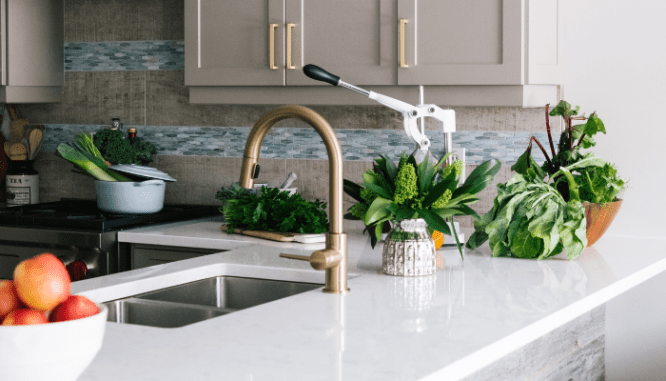Brass Is Back, Baby: Here’s the Latest on Today’s Brass Fixtures Style
- Published on
- 5 min read
-
 Gina Rodrigues Contributing AuthorClose
Gina Rodrigues Contributing AuthorClose Gina Rodrigues Contributing Author
Gina Rodrigues Contributing AuthorGina is a freelance writer and editor who specializes in real estate and personal finance. She brings more than ten years of experience as a licensed agent and property investor. When she isn’t writing, she can be found tending to the sheep and chickens at her suburban homestead outside of Seattle. Gina holds a B.A. in English from California State University.
Just as overalls, shoulder pads, and velvet dresses cropped up at the mall in recent years, brass fixtures reentered the home design scene. That’s right, the 1980s are back, baby, and the golden alloy has come along for the ride.
“Brass is super hot right now. We started seeing it a few years ago, creeping back into the design sphere,” comments Kate Touhill of Seattle Staged to Sell, a seven-time Houzz award-winning design firm.
But don’t expect to spit-shine your retro brass-plated fixtures and call it a day. Today’s iteration of brass is more subtle than the polished version ubiquitous in the ‘more is more‘ decade.
We spoke with interior design expert Touhill and two top real estate agents to get the latest intel on today’s brass trend. We’ll teach you how to pull this trend off and share how brass fixtures can impact your future home sale.

Brass of the past: A brief history
Like most finishes, brass has come in and out of style over the decades. Let’s take a quick look at the most recent takes on the trend:
Mid to late 1800s: Victorian Era
An alloy mix of copper and zinc, brass gained widespread popularity in home design during the Victorian era. The Industrial Revolution made it easier and more affordable to manufacture brass fixtures rather than forging iron fixtures by hand. Brass fixtures included intricate patterns of delicate swirls and crests reminiscent of filigree and acanthus. Beaded edging, scrollwork, and egg patterns were also common design elements of the time.
Late 1800s to 1920s: Arts and Crafts Movement
Brass remained a popular finish through the Arts and Crafts Movement, though the style adapted to the new ethos. Brass fixtures were simple with straight lines and symmetry preferred to ornamental excess.
1940s to 1960s: Mid-century Modern
Brass was a popular finish in Mid-century Modern design since its golden hue added warmth to the style’s futuristic aesthetic. The fixture designs emulated Mid-century Modern’s guiding principles: clean lines, sweeping curves, and geometric shapes.
1970s to 1990s: Modern Maximalism
Brass endured during the eclectic disco days of 1970s design that shifted between hippie boho and Saturday Night Fever. Brass finishes ranged from subdued bronze to shiny gold sheen, while the styles ran the gamut — reflecting the individualistic attitude of the ’70s.
In the 1980s, brass continued its reign in home design, reflecting the materialism and drive for consumerism that defined the decade. Like a Ferrari-driving yuppie with a maxed-out credit line, brass’s flashy gold finish was as ostentatious as it gets. Brass fixtures produced at this time were often plated (as opposed to solid) and tarnished with time and use.
2010s to today: Brass is the new black
After a much-needed hiatus, brass returned in the late 2010s — and yes, brass fixtures are still in style today. In contrast to the chromed finish previously popular, trending brass fixtures have a subdued brushed or satin finish.
Brass is the go-to metal in today’s most popular home design aesthetics, including Organic Modernism, Mid-century Modern, and Grandmillennial Style, yet can complement almost any interior design.
“Brass isn’t limited to any one particular design style,” Touhill comments. A homeowner with a French provincial kitchen can use brass pulls to complement the room’s existing style, she explains. “You can find [brass] in pretty much any style that you can think of.”

Bringing brass home: How to get the look
Replacing old fixtures and hardware with brass is one of the easiest, most affordable ways to update your living space. Here’s how to stay on trend without blowing your design budget.
Create a mood board
Touhill suggests seeking inspiration from sites like Pinterest and Instagram for examples of how to integrate brass with your interior style and color palette. Save your favorite photos and search for copycat designs online.
Mix brass with other metals
Matchy-matchy is out, and mixed metals are in. Brass complements nickel, bronze, chrome, and black metals, so feel free to use two finishes throughout your home. For example, you can install an antiqued brass faucet and lighting fixture to complement existing nickel drawer pulls.
If you’re intent on switching everything to brass, Touhill suggests playing with different finishes to add dimension. Just avoid blindingly gold brass — a big no-no, according to our experts. A bright, glittery brass pendant light may catch your eye, but the same shine could overwhelm the space and your future buyers.
“The biggest thing in brass to stay away from is the shiny brass because that’s what’s really going to end up looking dated,” warns Touhill.
Learn the lingo to shop like a pro
It’s easy to feel overwhelmed when browsing brass fixtures with the sheer number of finishes and colors available. Not to mention, manufacturers further complicate matters with different naming conventions.
“Their adjectives are all over the place,” notes Wendy Turner, a top real estate agent who sells homes 14% faster than the average agent in Greenville, SC. “One company calls it brushed, and another company calls it brushed, and it looks different.”
Here’s a breakdown of brass finishes available today:
- Satin and brushed: Satin and brushed are two matte finish options. Brushed brass includes brush stroke marks while satin does not. Today, these matte finishes are the most popular since they’re highly versatile and low-maintenance. The matte finish hides water spots better than shinier finishes, making matte fixtures ideal for bathrooms and kitchens.
- Lacquered: Lacquer coating seals the brass finish, keeping it from tarnishing. If an antiqued look is what you’re going for, choose an unlacquered brass fixture, which patinas over time. Some hardware comes in both lacquered and unlacquered finishes, such as Rejuvenation’s Beaux Arts solid brass door knob.
- Polished: Polished brass is the shiny, mirror-like gold finish popular in the ‘80s and ‘90s. Though easy to clean, polished brass shows every fingerprint and water spot. Include polished brass fixtures sparingly, if at all.
- Antiqued and weathered: Antiqued or weathered brass is manufactured to look like aged, unpolished brass. The finish is primarily brown with hints of gold.
Selling? Think twice before swapping to brass
Swapping out old hardware for new brass styles is an easy way to bring your home up to date. But are brass fixtures a smart choice if you’re selling your home? Consider these factors before making the switch.
Browse local home listings online to see if brass is trending in your market
Flip through online listings of homes for sale in your area. Do you see brass fixtures and hardware in the interior photos? If you don’t, you may want to stick to black or chrome fixtures.
“So much of it really is exposure. Has the buyer been exposed to this trend?” comments Turner. The more familiar buyers are with the latest brass wave, the more likely they will embrace the golden finish.
Consider your home’s architectural style
Your home’s architectural style may also make or break your decision to purchase brass fixtures. While brass fixtures suit a stately Victorian or Craftsman bungalow, the same fixtures would look out of place in a Mission Revival home where buyers expect to see black and iron fixtures.

Brass is in style, but all trends come and go
Brass is one of today’s most popular finishes, but there’s no telling how long this trend will continue. Top real estate agent Mary Stewart warns homeowners to approach any fixture trend with caution for this reason.
“I went through my whole house and painted everything oil-rubbed bronze — all the knobs, all the doorknobs, all the light switch plate covers. And now it’s out of style, and I’m sorry I did it,” shares Stewart who works with 82% more single-family homes than the average agent in Sugar Land, TX.
If you’re not planning to sell right away, choose fixtures that speak to you and spark joy, not because they’re on a design influencer’s must-have list. And whether you choose brass or a different finish, prepare to switch styles again in 10 to 15 years, when a new fixture trend is bound to emerge.
Header Image Source: (Chastity Cortijo / Unsplash)
